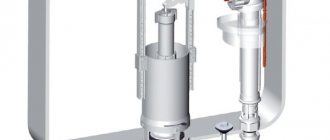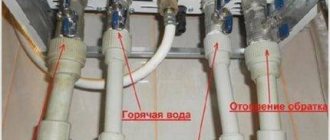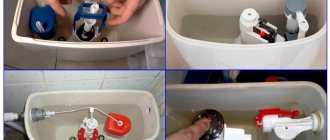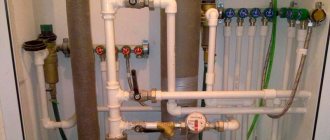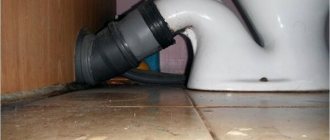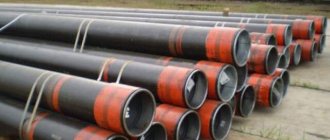Diagram and details
Any circuit consists of several nodes:
- A water drainage device is a drain pipe, a water release mechanism and a valve that stops the flow of water into the toilet. When we press the drain button, the valve rises. Water flows out of the tank at high speed through the drain pipe.
- A shut-off mechanism is a faucet that automatically turns off the water. The tap opens as soon as the water level has decreased. The float, as the tank is filled, will rise to a certain height and close the tap.
- Overflow system - protects the apartment from flooding if the locking mechanism fails. When the water level rises above a certain value, the overflow system ensures that it flows into the toilet.
Microlift design
The microlift is sold together with the toilet lid. It cannot be purchased separately. Toilet lids equipped with closers are made of plastic or its modern analogue - duroplast. Although this polymer looks like plastic in appearance, its quality characteristics are closer to ceramics.
The material for the manufacture of seats equipped with a microlift is duroplast - a modified polymer that can maintain a stable temperature when exposed to heat.
Fix the device to the toilet in a rigid way. But to ensure smooth operation of the mechanism, the device can be equipped with a function that provides air shock absorption. For this purpose, the seat is supplemented with special compartments, which are filled with shock-absorbing silicone.
- A rod that securely holds the rigid plastic installation.
- A spring whose force balances the weight of the structure.
- Hinged micro-lift mechanism that allows changing the position of the lid.
- Lid and seat made of durable polymer.
In more expensive functional systems, the basis of the mechanism is not springs and rods, but pistons and cylinders. Structures of this type are classified as non-removable.
Smooth closing/opening of the mechanism and fixation of the toilet lid in the desired position is ensured by a micro-lift hinge mechanism equipped with a spring
Functional systems, in which seats and covers are supplemented with a built-in microlift, are produced by many manufacturers of sanitary equipment. If desired, you can purchase and install a universal device that can provide several functions at once:
- adjusting the temperature of incoming water;
- possibility of seat heating;
- high-quality washing, enema and massage;
- extraction of unpleasant odors followed by deodorization.
Many models are often equipped with a convenient self-cleaning function, thereby minimizing the participation of household members in the process of using a plumbing fixture.
Signs of leakage
If the tank is leaking, you can observe the following:
- you can hear falling drops of water or a flowing stream;
- you can see rusty stains, lime deposits on the walls of the tank;
- a small wet trace is visible in the toilet bowl, which remains after flushing;
- the appearance of condensation on the outside or on the hoses;
- The water does not go away quickly after pressing the button.
If the water does not drain quickly or the level is incorrect, then the water pressure is not sufficient to pass the waste through the water seal. And some of it remains in the toilet bowl.
As soon as you detect one of the listed symptoms, you need to determine the cause and eliminate the problem.
What to do to prevent the tank from leaking
Timely implementation of preventive measures extends the service life of the toilet. To minimize the risk of a leak, several rules should be followed:
- Installation instructions. The technology differs for different models.
- No mechanical impact. Impacts, jolts or loosening of the tank will cause the sealing of the mounting holes to break.
- Regular cleaning. Periodically clean the internal surface from plaque and dirt. The frequency of cleaning depends on the degree of contamination and hardness of the water.
- Control over the work of governing bodies. When wedging the buttons, the parts are cleaned and lubricated.
The method for eliminating a toilet leak depends on the cause of its occurrence. A person with minimal technical knowledge and no experience in plumbing repair can restore the product’s functionality. Prevention makes it possible to increase the service life of the product.
Have you fixed the leak yourself? What was the reason for the water leakage? What tools were used during the repair?
A quick way to fix a toilet cistern leak in the video:
List of required tools
In order to eliminate the leak, you need to acquire some tools and consumables. During the repair process, it is necessary to replace unsuitable seals, hoses, and gaskets.
When the toilet cistern is leaking, you may need:
- sealant for plumbing work (silicone);
- sandpaper;
- limescale remover;
- Screwdriver Set;
- knife;
- pliers;
- a set of keys;
- fum tape (sealing tape for water).
Consequences of the problem
If you do not pay attention to the fact that water is leaking from the toilet cistern, the consequences can be very disastrous. Firstly, puddles will constantly form on the floor in the toilet , therefore, you risk flooding your neighbors, and you will have to make repairs to them at your own expense.
Secondly, constant leakage will lead to excessive consumption of cold water , which is unprofitable from an economic point of view. Thirdly, due to high humidity, mold or mildew may appear in a cramped room. This is not only unpleasant, but also dangerous to the health of people living in the apartment.
And finally, a faulty tank constantly makes noise , which is not very comfortable. Therefore, cistern leaks should be repaired as soon as possible.
External damage
Such breakdowns occur due to incorrect installation or non-compliance with the operating rules of the device. Let's look at the most common problems and their solutions.
You may be interested in the article “Soldering polypropylene pipes: temperature table, installation instructions + top best pp systems” Go>>
Crack in the base of the toilet
If you pour hot water into the toilet or drop something heavy, the toilet bowl may crack.
How to repair such a crack if it is at the base of the toilet:
- Prevent crack enlargement. Use a small drill to make small indentations along the edges of the crack.
- Sand the edges of the crack with sandpaper.
- Glue the earthenware with epoxy resin or use two-contact glue.
- Do not use the device until it is completely dry.
- If the glue fails, you will have to replace the bathroom.
The fasteners are not tightened tightly enough
If, shortly after installing the toilet, drops of water appear at the connection between the tank and the bowl, then the clamping nuts may not be tightened tightly. Therefore, the tank did not move much.
Tighten the nuts. By lightly rocking the drain tank, check whether they are screwed on well.
The toilet bowl burst
If you stand on the toilet bowl with your feet, large cracks may appear. Water will begin to leak through the cracks. In this case, repairs will not be possible; you will have to replace the toilet with a new one.
What to do if water is constantly flowing in the toilet
The design of the fittings of modern models differs from outdated systems with a rubber float bulb. New devices are equipped with two units: drain and float. A key or button activates the drain; it is carried out by the drain mechanism. After the container is empty, the water supply starts. It is already regulated by a float system.
Module design may vary depending on models. Their features can be found in the technical documentation or when disassembling the equipment. If the toilet tank is leaking, you will still have to disassemble it. It is important to remember that this can only be done with the shut-off valve on the supply line or on the riser entering the apartment closed. The reservoir must be emptied before doing this.
The disassembly scheme is simple. First, the drain button is unscrewed, then the lid is removed. After this it is easy to get the parts. The elements of the units are made of plastic and are fixed with bolts and plastic or rubber seals. Parts from different manufacturers are often interchangeable, so it is not difficult to find a replacement for a worn one. First you need to measure the worn-out product or bring it to the store.
Instagram vladimir_santex_churicov
Let's look at the main reasons why the toilet cistern leaks and how to fix the problem.
The seal has deteriorated
This is a ring made of rubber or plastic. It is located at the outlet of the water jet. It retains sediment, fragments of mineral deposits and other contaminants. Therefore, there are two reasons for such a breakdown: the part is either too dirty or worn out. In the second case, it becomes thinner, frayed or deformed. Whatever the reason, the water will flow constantly. The seal needs to be replaced or cleaned. The procedure is carried out according to this scheme.
- Remove the lid of the container. We dismantle the mechanism. To do this, turn the module to the left half a turn until it clicks.
- Prepare a cleaning solution with any mild soap. Cleaning the parts.
- We carefully inspect the seal. If there are cracks or deformation, replace it with a new one.
- We put the module in place.
Instagram vse_vidi_santexniki
- Plumbing equipment
How to install corrugation on a toilet: step-by-step instructions
Float mechanism failure
There may be two options here. The first is the loss of tightness of the float. In this case, it does not rise to the surface when the volume of liquid in the container increases. This is immediately noticeable upon visual inspection. When the tank is filled, the overflow system is activated, water flows from the tank into the toilet without interruption. The second option is a breakdown of the mechanism fastening. In any case, the module needs to be replaced. It's done like this.
- We carry out diagnostics. To do this, without emptying the tank, remove the lid. Press the drain key. Let's see how the float works.
- We dismantle the tank. Close the shut-off valve and activate the flush button. We unscrew the hoses and fasteners suitable for the container. Carefully remove the tank from the shelf-stand. It is heavy enough that it cannot be dropped.
- Remove the float. It must be carefully unscrewed and replaced with a new one. We place the unit in its seat and securely fix it with plastic fasteners.
- We place the tank on the toilet shelf and secure it with mounting pins. We connect the flexible liner.
- All that remains is to install the lid, open the stop valve and do a test flush.
Instagram mastervdomeufa
Short-term leakage after draining
Sometimes the tank leaks while it is being filled with new water. The cause may be a misalignment of the drain module. It's noticeable right away. The drain key begins to jam, sometimes it simply falls into the mounting hole. In this case, you need to dismantle the cover and remove the assembly. Most likely, he moved out a little from his seat. We need to place it correctly.
It happens that the water flow brings quite large particles of mineral sediment or solid contaminants. They get under the seal ring and break its tightness. In an empty tank, the pressure on the valve is low, and it allows liquid to pass through. As soon as the tank is full, the pressure increases and the stream is pinched. The problem can be resolved by thoroughly cleaning the parts.
It is possible that one of the valve components broke or was initially defective. Only replacement will help here. The unit is dismantled. Worn out elements are replaced if possible. If not, a new module is purchased. After repair or replacement, the mechanism is installed in the tank. A test run of water is being carried out.
Instagram macstep_vit
Cracks on the tank
Sometimes the cause of a leak lies in a violation of the integrity of the tank. Let's look at how to eliminate leakage if the toilet cistern is cracked and leaking. You must understand that you can fix the problem only temporarily. The best solution is to replace the plumbing, and this will still have to be done. As a temporary measure, minor repairs can be carried out. They do it like this.
- We dismantle the tank. To do this, empty it, remove the cover, and remove the fittings. We unscrew the fasteners and liner, remove the container from the toilet shelf.
- Dry the outer and inner surface of the tank well.
- Carefully seal all cracks with a suitable sealant. We act strictly according to the manufacturer's instructions. Let the material harden.
- We put the container in place and secure it with bolts. We connect the water supply and install the fittings.
It is unknown how long the equipment will work after repair. Therefore, it is advisable to plan to replace your plumbing fixtures in the near future.
Instagram mastervdomeufa
- Plumbing equipment
How to choose and correctly install a hygienic shower for a toilet
Preventing future breakdowns
To avoid unwanted leaks in the toilet, it is necessary to follow the operating rules and constantly carry out inspection and maintenance of the main modules.
Preventive actions:
- check the condition of fasteners, hoses, corrugations;
- periodically replace gaskets, bulb, shut-off valve. They must be elastic, not deformed, without cracks;
- clean from rust and limescale;
- check the position of the valves and float;
- do not allow hot water or heavy objects to come into contact with the toilet bowl;
- install a coarse filter;
- entrust the installation of your bathroom to professionals.
We tried to consider all possible cases of improper operation of the toilet flush system. We hope that you were able to repair the toilet and eliminate the damage. If we missed something and you encountered this problem, write to us about it in the comments. We will try to help you.
Causes
Why does the toilet cistern leak, is it possible and how exactly can I fix it, if it is leaking, with my own hands? A similar malfunction occurs when:
- the membrane from the siphon broke;
- the pear is very worn;
- the pear ceases to hold water due to limescale deposits on the saddle;
- the nut at the base of the overflow has become loose;
- the rubber between the tank and the toilet is leaking;
- rubber gaskets move or rot;
- the toilet tank has burst or cracked;
- the drain shut-off valve does not hold water very well;
- the connection between the water hose and the drain tank has become loose;
- the button height adjuster is offset;
- the threaded connection between the toilet platform and the flush tank has become loose;
- the tank mounting bolts are loose or rotten;
- The reinforcement fastening has broken.
Leaking due to float mechanism
A skewed float mechanism discovered during inspection of the tank may also be the cause of a toilet leak. The part can warp both due to external influences and as a result of the long service life of the plumbing fixtures. Having discovered a displacement of the float lever, you need to immediately begin to eliminate this problem.
You need to figure out what to do - the toilet is leaking after flushing, and the flow of water does not stop (for more details: “What to do if the toilet is leaking after flushing - options on how to fix the leak”). Diagnosing the problem looks very simple. First you need to inspect the float itself and find any possible damage. If the mechanism does not work, and there are no damage to it, then the only correct solution is to completely replace the float. It is advisable to immediately buy a high-quality part - this will reduce the likelihood of leaks in the future.
If you find a small hole in the float during inspection, you can use one of the temporary solutions:
- Firstly, the hole in the float can be hermetically sealed with polyethylene;
- Secondly, you can melt a small piece of plastic and use it to seal the hole in the float.
Temporary elimination of a leak only allows you to delay the replacement of the float, but in no case replaces full-fledged repair work.
How to get rid of noise when filling the tank
Most designs to reduce the noise level of water include the installation of a special drain pipe, through which water is discharged to its lower part when filling the tank.
First of all, check its installation. If the tube has fallen off, then put it on the fitting near the filling hydraulic valve. If such a tube is missing, try to select the required diameter and install it.
Another way to get rid of strong noise when filling is to reduce the flow rate of the supplied liquid. This can be done by closing the tap on the water supply line or installing a restriction washer on the hose fitting.
Siphon leak
The membrane installed in the siphon prevents leakage in the toilet. During operation, the part is subject to wear, so after some time it has to be replaced. When choosing a new membrane, you must take into account its shape and size - a mistake can lead to the fact that the part simply cannot be installed in place.
The technology for eliminating the problem with a leaking siphon is as follows:
- A crossbar connected to the float mechanism is installed in place of the tank lid;
- Flushing is carried out;
- The nut connecting the pipe to the tank is unscrewed;
- The siphon nut is slightly loosened so that it can be removed;
- The membrane is removed from the removed siphon;
- A new membrane is installed in place of the old membrane.
Reassembling the tank is done in the reverse order. If after assembly the problem is not solved, then you need to further understand what to do if the toilet tank is leaking.
Leaking hoses
The pipes that run between the tank and the water supply network usually have a sufficient safety margin and are very rarely damaged. The least durable section is the section in which the flexible hose is installed - that is, the inner section connecting the lever to the float mechanism. Most often, damage to this element manifests itself in the form of a leaking hose.
The standard reason for such a defect is weak tightening of the fasteners. If diagnostics have shown that this is the cause of the problem, then the problem can be fixed by simply tightening all fasteners. It is advisable to check the gasket before doing this - most likely, it has already lost its properties, so it should be replaced.
With metal fasteners everything is quite simple, but plastic fasteners require careful actions. The thing is that bolts made of plastic are not particularly strong, so excessive force can lead to their breakage. In addition, in this case there is also a risk of thread failure - and this is fraught with serious consequences, including the need to completely replace the plumbing.
A leaking corrugated pipe can also cause leaks, in which case the part must be replaced. There is no need to dwell on this point for a long time - changing the toilet bowl corrugation is very easy. In addition, this part is very cheap, so repairs if it breaks will be budget-friendly.
